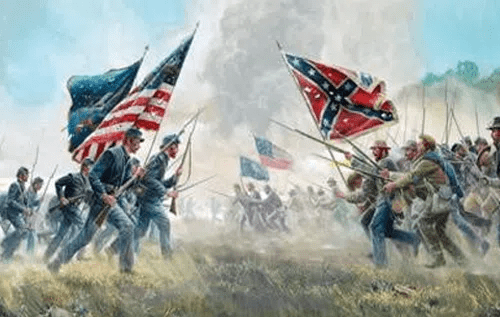10th Arkansas Infantry Regiment

 The Tenth Arkansas Infantry Regiment was organized at Springfield in Conway County in July 1861. This is where many volunteers from Van Buren County (southern Van Buren County later became Cleburne) were mustered into the Confederate Army. Company “A,” known as “Quitman Rifles,” was headed by Captain A. R. Witt. Other officers were First Lt. W. W. Martin, Second Lt. C. M. Cargile, Third Lt. Israel Davis, and First Sergeant W. R. Corbin. The company had eight non-commissioned officers and 94 men in all.
The Tenth Arkansas Infantry Regiment was organized at Springfield in Conway County in July 1861. This is where many volunteers from Van Buren County (southern Van Buren County later became Cleburne) were mustered into the Confederate Army. Company “A,” known as “Quitman Rifles,” was headed by Captain A. R. Witt. Other officers were First Lt. W. W. Martin, Second Lt. C. M. Cargile, Third Lt. Israel Davis, and First Sergeant W. R. Corbin. The company had eight non-commissioned officers and 94 men in all.
Company “G” was called “Red River Riflemen.” Officers were Captain John B. Miller, First Lt. James E. Lockard, Second Lt. Henry J. Gatton, Third Lt. Edwin Ellis, and First Sergeant Daniel Johnson. This company with ten non-commissioned officers had 91 men.
Other companies in the regiment were the “Randy Rifles,” the “Choctaw Riflemen” from Conway County, “Pemberton’s Company,” “Muddy Bayou Heroes,” “Perry County Mountaineers…… Conway Tigers,” and “Springfield Sharpshooters.” Field and staff officers for the Tenth were Colonel T. D. Merrick, Lt. Col. S. S. Ford, Major Obed Patty, and Adjutant Robert C. Bertrand.’
Tenth Arkansas Infantry
The Tenth Arkansas Regiment was assigned to General Bowen’s Brigade, consisting of the Ninth and Tenth Arkansas, Fifth Missouri and Tenth Mississippi regiments before they were moved to Kentucky. They remained at Bowling Green until the evacuation of that place when they were placed to guard the rear on the retreat. They were then placed in Hardee’s Corps and marched to Corinth. Here the Ninth Arkansas was put in Breckenridge’s Reserve Corps and marched to Shiloh. In this battle they lost about 160 men.
After the Battle of Shiloh the regiment, as part of Beauregard’s CSA Army, withdrew back to Corinth, where they reorganized. Formal charges related to the disorganized condition of his regiment were brought against Col. Merrick. He resigned and on May 27, 1862 Captain A. R. Witt of Company “A,” “The Quitman Rifles,” was promoted to colonel and became commander of the regiment. Here their brigade was broken up.
They were moved first back of Vicksburg, where they stayed some time on the Yazoo River, at Camp Price. Then they were moved to Vicksburg, where they stayed a short while. They were placed in a brigade commanded by General Jeff Thompson and moved to Louisiana, 30 or 40 miles above New Orleans, where they spent the winter of 1862-63 guarding the New Orleans, Jackson and Great Northern Railway.
By the early spring of 1863, Beauregard’s Army, with the Tenth Arkansas was sent again to Baton Rouge where they were to prepare defenses against the approaching General N. P. Banks. This they did by felling large numbers of trees to block the roadways leading to Baton Rouge, digging trenches and mounting siege guns around the city.
By the first of March, 1863, the Tenth Arkansas Infantry was at Port Hudson, Louisiana above New Orleans and during March 7-27 as part of a CSA force under General Franklin Gardner, they were in operations against Federal forces at Port Hudson. After a series of engagements lasting into July, 1863, the Tenth Arkansas Infantry, was part of a Conderate force surrendered by Gen Gardner to Union General N. P. Banks, a surrender that was apparently helped along by internal dissension within the regiment. Certain officers of the Tenth Arkansas seemingly were able to influence some enlisted men to desert and refuse to alternate duties with their fellow companies. By July 7, just two days before the regiment capitulated, there was practically open mutiny.
On July 9, 1863 the entire regiment surrendered and became prisoners of war. The men were paroled until exchanged, with the officers imprisoned at Johnson’s Island, Ohio, in Lake Erie. The unit was eventually exchanged and returned to Arkansas. Col. A. R. Witt reorganized the unit, including some newly recruited members to form Witt’s Cavalry.
John F. Walter in his Capsule History of Arkansas Military Units gives additional information on the Tenth Arkansas Infantry and Witt’s Arkansas Cavalry.
This unit [the Tenth Arkansas Infantry] served east of the Mississippi River throughout its career. Listed below are the higher command
- Oct. 31, 1861, Sixth Brigade, First Division, Western Department.
- Nov. 30, 1861, Second Brigade, Fourth Division, Western Department.
- Jan. 31, 1862, Bowen’s Brigade, Floyd’s Division, Central Army of Kentucky.
- Feb. 22, 1862, Second Brigade, Third Division, Central Army of Kentucky, Western Department.
- April 6, 1862, Second Brigade, Reserve Corps, Army of the Mississippi.
- March 31, 1863, Buford’s Brigade, Third Military District, Department of Mississippi and East Louisiana.
- April 30, 1863, Maxey’s Brigade, Third Military District, Department of Mississippi and East Louisiana.
Like almost all Civil War units, the regiment was frequently known by an alternate designation derived from the name of the unit’s commanding officer. Names of this type identified as having been used by or for the Tenth Arkansas Infantry are listed below.
- A. R. Witt’s Infantry
- C. M. Cargile’s Infantry
- E. L. Vaughan’s Infantry
- Thomas D. Merrick’s Infantry
- S. S. Ford’s Infantry
- Obed Patty’s Infantry
- George A. Merrick’s Infantry
- Zebulon Venable’s Infantry
- Robert C. Bertrand’s Infantry
The regiment participated in the following engagements during its career:
- Battle, Pittsburg Landing, Shiloh, Tenn. – April 6-7, 1862
- Engagement, Baton Rouge, La. – Aug. 5, 1862
- Operations against expedition from Pass Manchac and Ponchatuoula, La. – Sept. 13-15, 1862
- Skirmish, Bayou Bonfonca, La. – Nov. 21, 1862
- Operations against Port Hudson, La. – Mar. 7-27, 1863
- Action, Plain’s Store, La. May 21, 1863
- Siege, Port Hudson, La. May 24-July 9, 1863
- Assault, Port Hudson, La. – May 27, 1863
- Assault, Port Hudson, La. – June 14, 1863
- Surrender, Port Hudson, La. – July 9, 1863
At its organization the Tenth Arkansas Infantry numbered 1000 men; yet at the close of the war there were not more than 200 men surviving.
Witt’s 10th Arkansas Cavalry
Witt’s Arkansas Cavalry, commanded by Colonel A. R. Witt, was composed primarily of men who had served with the Tenth Arkansas Infantry, been captured at Port Hudson, Louisiana, and after being exchanged, returned to Arkansas.
On numerous occasions, the unit served behind Federal lines. A Federal report indicated that it often employed female sympathizers to spy on Federal installations and troop movements, reporting the information obtained back to the command. One of these spies was reported to be operating in Little Rock in mid-November, 1864.
The unit served unattached throughout its career, with the exception of Price’s Missouri Expedition in late 1864. During this time it appears to have been attached to Fagan’s forces.
Below are the engagements in which the unit took part.
- Skirmishes, Clear Creek and Tomahawk, Ark. – Jan. 22, 1864
- Skirmish, Rolling Prairie, Ark. – Jan. 23, 1864
- Skirmish, Sylamore Creek, Ark. – Jan. 23, 1864
- Skirmishes near Burrowsville, Ark. – Jan. 23, 1864
- Skirmish, Crooked Creek, Ark. – Feb. 5, 1864
- Skirmish, Bayou Des Arc, Ark. – July 13-16, 1864
- Skirmish, Gum Swamp, Ark. – July 17, 1864
- Skirmish, Austin, Ark. – July 17, 1864
- Operations against Expedition from Little Rock to the Little Red River, Ark. – Aug. 6-16, 1864
- Price’s Missouri Expedition – Aug. 29-Dec. 2, 1864
- Skirmish near Quitman, Ark. (detachment) – Sept. 2, 1864
- Skirmish, Ironton, Mo. – Sept. 26, 1864
- Skirmishes, Arcadia and Ironton, Mo. – Sept. 27, 1864
- Battle, Marmiton (Charlot), Mo. – Oct. 25, 1864
- Engagement, Mine Creek, Little Osage River, Marias des Cygnes, Kan. – Oct. 25, 1864
- Skirmish near Lewisburg, Ark. – Feb. 12, 1865
Unlike most of the units which accompanied Price after the Missouri expedition, Witt’s Cavalry did not retreat all the way to northeastern Texas. The command remained, instead, in Arkansas, probably in order to continue its spying operations. The Third Arkansas (United States) Cavalry met and destroyed Witt’s command at the Lewisburg engagement.
The Tenth Arkansas Infantry Regiment was not the only unit which recruited men of Cleburne County. At least seven companies were raised in White County during 1861 and 1862 and others in Independence County.



